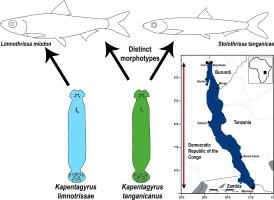International Journal for Parasitology ( IF 3.7 ) Pub Date : 2020-04-08 , DOI: 10.1016/j.ijpara.2020.02.002 Nikol Kmentová 1 , Stephan Koblmüller 2 , Maarten Van Steenberge 3 , Joost A M Raeymaekers 4 , Tom Artois 5 , Els L R De Keyzer 6 , Leona Milec 4 , Fidel Muterezi Bukinga 7 , Théophile Mulimbwa N'sibula 7 , Pascal Masilya Mulungula 7 , Gaspard Ntakimazi 8 , Filip A M Volckaert 9 , Milan Gelnar 10 , Maarten P M Vanhove 11

|
Lake Tanganyika, East Africa, is the oldest and deepest African Great Lake and harbours one of the most diverse fish assemblages on earth. Two clupeid fishes, Limnothrissa miodon and Stolothrissa tanganicae, constitute a major part of the total fish catch, making them indispensable for local food security. Parasites have been proposed as indicators of stock structure in highly mobile pelagic hosts. We examined the monogeneans Kapentagyrus limnotrissae and Kapentagyrus tanganicanus (Dactylogyridae) infecting these clupeids to explore the parasites’ lake-wide population structure and patterns of demographic history. Samples were collected at seven sites distributed across three sub-basins of the lake. Intraspecific morphological variation of the monogeneans (n = 380) was analysed using morphometrics and geomorphometrics of sclerotised structures. Genetic population structure of both parasite species (n = 246) was assessed based on a 415 bp fragment of the mitochondrial cytochrome c oxidase subunit I (COI) gene. Overall, we observed a lack of clear geographical morphological differentiation in both parasites along a north–south axis. This lack of geographical population structure was also reflected by a large proportion of shared haplotypes, and a pattern of seemingly unrestricted gene flow between populations. Significant morphological and genetic differentiation between some populations might reflect temporal differentiation rather than geographical isolation. Overall, the shallow population structure of both species of Kapentagyrus reflects the near-panmictic population structure of both host species as previously reported. Morphological differences related to host species identity of K. tanganicanus were consistent with incipient speciation at the genetic level. Both parasite species experienced a recent demographic expansion, which might be linked to paleohydrological events. Finally, interspecific hybridisation was found in Kapentagyrus, representing the first case in dactylogyrid monogeneans.
中文翻译:

单殖吸虫 Kapentagyrus spp. 弱的种群结构和最近的人口扩张。感染东非坦噶尼喀湖的鲇鱼。
东非坦噶尼喀湖是非洲最古老、最深的大湖,拥有地球上最多样化的鱼类群落之一。两种鲢科鱼类Limnothrissa miodon和Stolothrissa tanganicae占总渔获量的主要部分,对当地粮食安全必不可少。寄生虫已被提议作为高度流动的远洋宿主种群结构的指标。我们检查了单殖吸虫 Kapentagyrus limnotrissae和Kapentagyrus tanganicanus(Dactylogyridae) 感染这些 clupeids 以探索寄生虫的全湖种群结构和人口历史模式。在分布在湖泊的三个子流域的七个地点收集了样品。 使用硬化结构的形态计量学和地貌计量学分析了单殖亚纲动物 ( n = 380) 的种内形态变异。 基于线粒体细胞色素c的 415 bp 片段评估了两种寄生虫物种(n = 246)的遗传种群结构氧化酶亚基 I (COI) 基因。总体而言,我们观察到两种寄生虫沿南北轴都缺乏明显的地理形态差异。这种地理种群结构的缺乏也反映在很大比例的共享单倍型以及种群之间看似不受限制的基因流动模式上。一些种群之间显着的形态和遗传差异可能反映了时间差异而不是地理隔离。总体而言,如先前报道的那样,两种Kapentagyrus物种的浅层种群结构反映了两种宿主物种的近乎混乱的种群结构。与K. tanganicanus宿主物种同一性相关的形态差异在基因水平上与早期物种形成一致。这两种寄生虫物种最近都经历了人口扩张,这可能与古水文事件有关。最后,在Kapentagyrus中发现了种间杂交,这代表了dactylogyrid monogeneans 中的第一个案例。











































 京公网安备 11010802027423号
京公网安备 11010802027423号